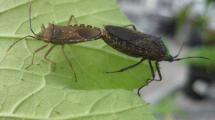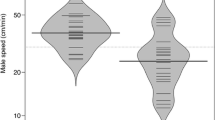Summary
This study tests the general prediction that discrimination among potential mates increases with the availability of potential mates. Specifically, we conducted two experiments that examined mate choice by male zaprochiline katydids in relation to their prior encounter rate with females. The probability of mate acceptance or rejection was measured for males given either frequent or no contact with females in the laboratory (experiment 1) and males taken directly from natural areas of either high or low female abundance (experiment 2). In both experiments, males with low female encounter rates were more likely to mate than males with high female encounter rates. In both cases, the decreased mating probability of males in the high encounter treatment resulted from their tendency to reject lighter (and less fecund) females. Despite the presumed advantage to males of selecting heavier females, field data indicate that, unlike females, males do not aggregate in rich food patches. Possible explanations for this finding are discussed.
Similar content being viewed by others
References
Alatalo RV, Lundberg A, Glynn C (1986) Female pied flycatchers choose territory quality and not male characteristics. Nature 323:152–153
Bailey WJ, Simmons LW (1991) Male-male behaviour and sexual dimorphism of the ear of a zaprochiline tettigoniid (Orthoptera: Tettigoniidae). J Insect Behav 4:51–65
Berven KA (1981) Mate choice in the wood frog, Rana sylvatica. Evolution 35:707–722
Greenfield MD, Alkaslassy E, Wang G-Y, Shelly TE (1989) Longterm memory in a territorial grasshopper. Experientia 45:775–777
Gwynne DT (1988) Courtship feeding and the fitness of female katydids (Orthoptera: Tettigoniidae). Evolution 42:545–555
Gwynne DT, Bailey WJ (1988) Mating system, mate choice and ultrasonic calling in a zaprochiline katydid (Orthoptera: Tettigoniidae). Behaviour 105:202–223
Gwynne DT, Simmons LW (1990) Experimental reversal of courtship roles in an insect. Nature 346:172–174
Johnson LK, Hubbell SP (1984) Male choice. Experimental demonstration in a brentid weevil. Behav Ecol Sociobiol 15:183–188
Lawrence WS (1986) Male choice and competition in Tetraopes tetraophthalmus: effects of local sex ratio variation. Behav Ecol Sociobiol 18:289–296
Lee JC, Bernays EA (1990) Food tastes and toxic effects: associative learning by the polyphagous grasshopper Schistocerca americana (Drury) (Orthoptera: Acrididae). Anim Behav 39:163–173
Moore AJ, Moore PJ (1988) Female strategy during mate choice: threshold assessment. Evolution 42:387–391
Parker GA (1978) Searching for mates. In: Krebs JR, Davies NB (eds) Behavioural ecology: an evolutionary approach. Blackwell Scientific Publications, Oxford, pp 214–244
Searcy WA (1982) The evolutionary effects of mate selection. Annu Rev Ecol Syst 13:57–85
Simmons LW (1990) Nuptial feeding in tettigoniids: male costs and the rates of fecundity increase. Behav Ecol Sociobiol 27:43–47
Simmons LW, Bailey WJ (1990) Resource influenced sex roles of zaprochiline tettigoniids (Orthoptera: Tettigoniidae). Evolution 44:1853–1868
Stephens DW, Krebs JR (1986) Foraging Theory. Princeton Univ Press
Thronhill R (1984) Alternative female choice tactics in the scorpionfly Hylobittacus apicalis (Mecoptera) and their implications. Am Zool 24: 367–384
Villalobos EM, Shelly TE (1991) Correlates of male mating success in two species of Anthidium bees (Hymenoptera: Megachilidae). Behav Ecol Sociobiol 29:47–53
Waage JK (1987) Choice and utilization of oviposition sites by female Calopteryx maculata (Odonata: Calopterygidae). Behav Ecol Sociobiol 20:439–446
Wilson DS, Hedrick A (1982) Speciation and the economics of mate choice. Evol Theor 6:15–24
Author information
Authors and Affiliations
Additional information
Offprint requests to: T.E. Shelly at the present address
Rights and permissions
About this article
Cite this article
Shelly, T.E., Bailey, W.J. Experimental manipulation of mate choice by male katydids: the effect of female encounter rate. Behav Ecol Sociobiol 30, 277–282 (1992). https://doi.org/10.1007/BF00166713
Received:
Accepted:
Issue Date:
DOI: https://doi.org/10.1007/BF00166713




